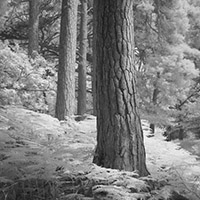Video: Thomas Heaton had his Fuji X-T3 converted to infrared & his first IR photos are awesome
posted Saturday, June 25, 2022 at 5:30 AM EST

Photographer Thomas Heaton recently sent his Fujifilm X-T3 camera to Protech Photographic to have it converted to infrared for black and white landscape photography. Heaton settled on a 720nm filter, which is considered a "classic" or "standard" infrared filter. It allows for some visible light and generally delivers good contrast for black and white photography. You can read more about filter choices at Kolari Vision.
Most years, Heaton struggles a bit during the summer months with his landscape photography. As a landscape photography enthusiast, I know the pain. Extremely early sunrises, very long days, a lot of haze, and busy locations can make any landscape photographer want to pull their hair out. "I much prefer winter and autumn time," says Heaton. However, he hoped that sending his camera in for an infrared conversion, which took about three weeks and cost a bit over $300, would change his opinion on summer landscape photography and give him a nice boost of enthusiasm.
Of course, you may not want to convert your primary camera to infrared. But, if you have a second camera sitting around, it could be a worthwhile investment. It's not terribly expensive – and it's certainly more affordable than buying the latest camera or lens – and it's not too difficult to come to grips with. Unlike a new camera or lens, an infrared conversion transforms the way your photos look. There's no way to accurately replicate the effect in your photo editing software. Like a polarizing filter, an infrared camera sees the light fundamentally differently.
I was fortunate enough to have my first experience with infrared photography earlier this year when I went hands-on with the Phase One XT camera and IQ4 150MP Achromatic digital back. That digital back doesn't include an IR-cut filter in front of its sensor, so it can do infrared photography if you attach a filter that blocks wavelengths of UV light. If you'd like to see some IR images with that camera, head to my review.
Readers, have you ever tried infrared photography? Are you interested in giving it a go? Let us know in the comments below. To see more from Thomas Heaton, visit his website, YouTube channel and Instagram.
(Via Thomas Heaton)